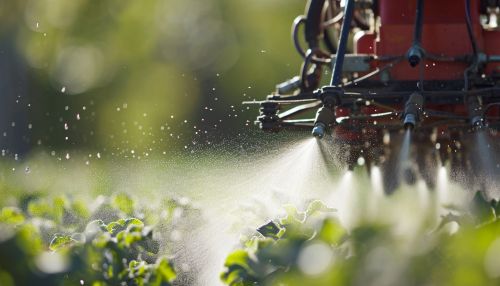Pesticides
Introduction
Pesticides are substances or mixtures of substances intended for preventing, destroying, repelling, or mitigating any pest. Derived from the term "pesticide", it is a broad term that covers a range of compounds including insecticides, fungicides, herbicides, rodenticides, molluscicides, nematicides, plant growth regulators and others. These substances have a crucial role in controlling the pests that affect plant and animal health and significantly impact agricultural production.
History
The use of pesticides dates back to antiquity. Ancient Sumerians used sulfur compounds to control insects and mites, while the Greeks and Romans used plant extracts to control pests. The Chinese also used arsenic for pest control in the 15th century. The industrial revolution led to the development of the first synthetic insecticide, DDT, in the mid-20th century. However, the environmental and health impacts of DDT and other similar compounds led to a shift towards the development and use of more environmentally friendly pesticides in the late 20th and early 21st centuries.


Classification
Pesticides can be classified based on their chemical composition, their mode of action, the type of pests they control, or their physical state. The most common classification is based on the type of pests they control. Insecticides are used to control insects, fungicides control fungi, herbicides control weeds, and rodenticides control rodents. Each of these classes can be further divided into subclasses based on their chemical composition or their mode of action.
Chemical Composition
Pesticides can be organic, inorganic, synthetic, or biological. Organic pesticides are derived from plants and animals, inorganic pesticides are derived from minerals, synthetic pesticides are chemically synthesized, and biological pesticides are living organisms that control pests. Each of these types has its advantages and disadvantages and is used in different situations.
Mode of Action
The mode of action of a pesticide is the way it affects the pest. It can be contact (kills on direct contact), systemic (absorbed by the plant and kills the pest when it feeds on the plant), or fumigant (kills pests in the soil). Understanding the mode of action is important for effective pest control and for managing pesticide resistance.
Environmental Impact
Pesticides can have significant environmental impacts. They can contaminate soil, water, turf, and other vegetation. In addition to killing pests, they can also harm or kill non-target organisms, including birds, fish, beneficial insects, and non-target plants. Pesticides can also affect biodiversity, particularly when they are used inappropriately or excessively.
Health Effects
Exposure to pesticides can cause a range of health effects, from skin and eye irritation to more serious effects such as cancer and endocrine disruption. Workers who handle pesticides are at the highest risk, but people can also be exposed to pesticides through food, water, and air. Children are particularly vulnerable to pesticide exposure.
Regulation
Pesticides are heavily regulated to protect human health and the environment. In many countries, pesticides must be registered before they can be sold or used. The registration process includes testing the pesticide to determine its efficacy and its potential impacts on human health and the environment. Pesticides that pose unacceptable risks can be banned or their use can be restricted.
Future Trends
The future of pesticides lies in the development of more targeted and environmentally friendly products. This includes the development of biopesticides, which are derived from natural materials such as animals, plants, bacteria, and certain minerals. Other trends include the use of nanotechnology to deliver pesticides more effectively and the use of genetic engineering to develop pest-resistant crops.
See Also
Integrated Pest Management (IPM) Biopesticides Pesticide Resistance
